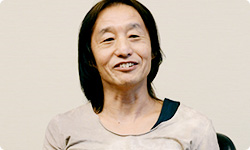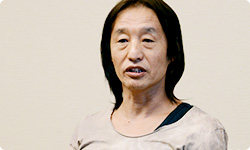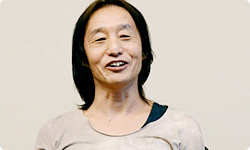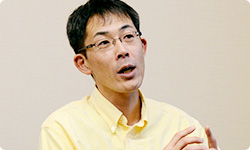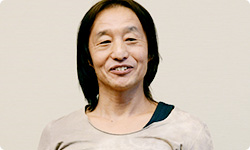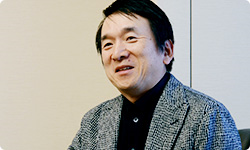Template:Interviews Navbox
| Interviews | |
|---|---|
| Pokémon Mystery Dungeon | Template:10 questions with Tsunekazu Ishihara Executive Producer of Pokémon Mystery Dungeon: Explorers & Darkness • This Q&A was posted to the website iwataasks.nintendo.com by unknown on November 15, 2012.[1]
Questions and AnswersAn Impossible CombinationIwata: I'm delighted to be joined today by Ishihara-san, from the Pokémon Company1, and Nagahata-san and Tomie-san from Spike Chunsoft2. I'd like to ask you all about Pokémon Mystery Dungeon: Gates to Infinity. Ishihara-san, you have appeared in a number of Iwata Asks interviews, so I don't think there's any need for you to re-introduce yourself! (laughs). Nagahata-san, you're someone who's been involved with the Mystery Dungeon series from the start, and you have worked on titles such as Torneko no Daibōken3 and Shiren the Wanderer4. Could you tell us what your involvement was with this game? 1. The Pokémon Company: The company responsible for managing the Pokémon brand and operating Pokémon Centers in seven locations across Japan. The company was established in 2000, and has its headquarters in Tokyo. 2. Spike Chunsoft Co., Ltd.: The developer responsible for planning, development, sales, and operations on series such as Pokémon Mystery Dungeon and Shiren the Wanderer. The company was established in 2012, and has its headquarters in Tokyo. 3. Torneko no Daibōken: Fushigi no Dungeon: A part of the Mystery Dungeon dungeon-based RPG series. The first title in the series, Torneko no Daibōken: Fushigi no Dungeon, was released in Japan for the Super Famicom in September 1993. 4. Shiren the Wanderer: A part of the Mystery Dungeon dungeon-based RPG series. The first title in the series, Mystery Dungeon: Shiren the Wanderer, was released in Japan for the Super Famicom in December 1995. Nagahata: I was responsible for overall planning and direction for this title.
Tomie: In the past, I've worked on scripts and storyboarding for the Shiren the Wanderer series. On this title, I was mainly responsible for writing the script.
5. Pokémon Mystery Dungeon: A part of the Mystery Dungeon series, based on Pokémon characters. The first titles in the series, Pokémon Mystery Dungeon: Blue Rescue Team and Red Rescue Team, were released in November 2005 in Japan and September 2006 in North America. Blue Rescue Team was released for Nintendo DS, while Red Rescue Team was released for the Game Boy Advance. Ishihara: That's right, yes. It could take a while to explain, though… which version of the story would you prefer, the really long version or the short version? (laughs)
Ishihara: Understood! (laughs) Well, Chunsoft and I have had a working relationship ever since we were both involved in a Famicom game called Tetris 2 + Bombliss6. One of the main factors that led to the creation of Pokémon Mystery Dungeon, however, was the way I felt after playing Torneko no Daibōken. I was really surprised by the depth and quality of that game. Mystery Dungeon games have their roots in old-school RPG titles, the type they often call 'roguelike'7 games. 6. Tetris 2 + Bombliss: A puzzle game released in Japan for the Famicom in December 1991. Ishihara-san was the producer and the director was Koichi Nakamura (former president of Chunsoft, current president of Spike Chunsoft). 7. 'Roguelike': Derived from a game called Rogue, a dungeon-exploring computer RPG, developed for Unix systems in 1981. Games that are said to use a similar format to Rogue are collectively known as 'roguelike' games.
Ishihara: At the time, the tagline for the game claimed that it was a "game you could play a thousand times" and I think that I, for one, really did! After I started working on the Pokémon games, therefore, I was always really keen to create a game that would connect Pokémon to the Mystery Dungeon series. Pokémon Mystery Dungeon was the game that arose from that desire.
Ishihara: That's right. It was Tomie-san who came up with the story concept of 'One day, you become a Pokémon!' back when we were working on the original title, and he has been developing the stories based upon that concept.
Nagahata: No, we didn't. At that time, Dragon Quest-style RPGs were the mainstream and very little was known about roguelike games, generally. So it was definitely a bit of a gamble. After all, players would sometimes play roguelike games for hours or even tens of hours, only to suddenly be dumped right back in square one with all their progress wiped out. Basically, however, all the development staff told us that this kind of game was definitely enjoyable, and that gave us the motivation we needed to get started.
Nagahata: Yes, we were. It was a real relief that, when the game was released, more people than we expected were willing to embrace it.
Nagahata: I must admit, when I first heard what we were planning, I did wonder whether it was going to work…
8. Pokémon Conquest: A strategy game, released for Nintendo DS in March 2012in Japan and June 2012 in North America. It was developed through collaboration between the Pokémon Company and Tecmo Koei, and combined elements from Pokémon games and from the Nobunaga's Ambition series. Nagahata: That's right.
Nagahata: I think one of the reasons was that the script Tomie-san wrote was so good, we could incorporate it really smoothly into the structure of the game. I think we also did a good job of expressing the charm of the Pokémon through our pixel art.
Tomie: Ultimately, the question I sought to answer was: "How can I bring out the charm of the Pokémon?" Actually, the first script I wrote was not one where you become a Pokémon, but something altogether different. When I showed this script to Ishihara-san, however, I said I had another idea of my own and proceeded to tell him about it…
Tomie: Yes. That was the idea Ishihara-san decided to go with. It's certainly the case that, when I considered game-type stories, I thought that one where the player becomes a Pokémon definitely allows for more empathy.
Ishihara: I felt that it would allow for a game that no one had experienced before. I also felt that, as a Mystery Dungeon story, it was the most real and fitting choice. I daresay that the true essence of Mystery Dungeon is a game in which players compete with each other to be defeated in ever more impressive ways! (laughs)
Ishihara: By combining that kind of unique aspect of dungeon-based RPG with Tomie-san's script, I think our games are well deployed as devices that allow players to read deeper into the Pokémon legend. With the first title in the series, I felt that we'd added new elements to the type of RPG we wanted to create and broadened the game's horizons as a result. The System is the StoryIwata: I'd like to ask you, Tomie-san, how do you go about writing a script for a dungeon-based RPG in which players could be said to be battling against themselves? Tomie: Dungeon-based RPGs are games in which skillful players can clear dungeons with ease. This can make incorporating a story very difficult. I remember having real trouble with this while working on the first Shiren the Wanderer, in particular.
Tomie: That's right. Having said that, I think that in the case of the Mystery Dungeon series, the system is the story.
Tomie: Well, in an ordinary RPG, players cannot acquire powerful weapons until near the end of the game. In Mystery Dungeon, however, because the map and items change every time a player enters a dungeon, the randomization process can mean that a player suddenly finds the most powerful weapon of all right at the start of the game. From that moment on, their story is going to be very different for that player.
Tomie: Yes. In other words, their story has changed because of the game system. As the scriptwriter, I took great care to make sure I didn't damage this feature.
Nagahata: I was surprised at how well the game was received by Pokémon fans. That was unexpected. Of course, we had the story and the charming characters on our side, but the structure of the game itself is actually rather different when compared to an ordinary RPG.
9. Shi-Ranger: A nickname given to passionate fans of the Shiren the Wanderer series. Ishihara: Yes, I did. The fact that fans of both Pokémon and Mystery Dungeon thought that this seemed like an interesting title justified our collaboration.
10. Time and Darkness: References to Pokémon Mystery Dungeon: Explorers of Time and Explorers of Darkness, the second titles in the Pokémon Mystery Dungeon series, released for Nintendo DS in September 2007 in Japan and April 2008 in North America. Pokémon Mystery Dungeon: Explorers of Sky was the next entry in the series, released for Nintendo DS in April 2009 in Japan and October 2009 in North America. Nagahata: Well, we wanted to include more new Pokémon and have a more dramatic storyline. Also, the first title was developed with the Game Boy Advance as the base system. For the second round of titles, we switched to using Nintendo DS as the base system. Ishihara: If I may add, the first titles were developed during a period of hardware transition, from Game Boy Advance to Nintendo DS, so the Blue version on Nintendo DS was based on the Game Boy Advance version's structure. For the second titles, we really made the most of the potential of Nintendo DS.
Nagahata: In general, I was keen to use all of the capabilities of Nintendo 3DS and I think we largely managed to achieve that. The Magnagate11 feature, which uses AR technology12, is an example of this. We also use the motion controls in a treasure-hunting mini-game. 11. Magnagate: A feature of Pokémon Mystery Dungeon: Gates to Infinity that uses the outer cameras of Nintendo 3DS. Scanning a circular object with the outer cameras of your Nintendo 3DS system allows you to open a completely new dungeon entrance, known as a Magnagate, within the game. 12. AR technology: Short for augmented reality technology. It involves combining virtual data with real-life images.
Nagahata: Players can play with each other either competitively or co-operatively. For example, players can work together to defeat big bosses according to the same single-player rules of Mystery Dungeon .
Tomie: The question was what to change and what to keep. The first thing to note is that the classic tale, the tale of friendship between the main character and their partner, has not changed. Just because it's a classic tale doesn't mean it was easy, though…
Tomie: Well, classic stories are easy to understand. To put it bluntly: there is justice, there is evil, the world is in danger, a hero appears to save the world, the world is saved, everyone's happy... that kind of pattern.
Tomie: Yes, it is. It's crucial that your stories remain both unpredictable and plausible. It's difficult to make very common stories interesting. Having said that, if you do pull off a classic story successfully, it's one of the most powerful types of story there is. That's why it's something I've tried to do throughout the Pokémon series.
Ishihara: Well, I did really want to include some kind of AR feature.
Ishihara: Yes, that's right. I wanted to create a system where scanning something using AR causes the nature of a dungeon to change, but also using AR in a way similar to what we did with Pokémon Dream Radar13 and Pokédex 3D14. For example, there may be a manhole cover near you that looks just like a dungeon entrance. I wondered whether we could create a game in which players would think "The monsters in that sewer are really tough!". 13. Pokémon Dream Radar: A downloadable title for Nintendo 3DS in June 2012 in Japan and October 2012 in North America. Pokémon appear in a player's real-world surroundings, displayed using the camera of Nintendo 3DS, and must be captured using a beam. Captured Pokémon can be transferred to a player's Pokémon Black Version 2 / Pokémon White Version 2 game. 14. Pokédex 3D: A downloadable title released for the Nintendo 3DS in June 2011. It allowed players to view their 3D models of their favorite new Pokémon from Pokémon Black / Pokémon White from whatever angle they choose. Pokédex 3D is no longer available for download, but an upgraded version called Pokédex 3D Pro can be downloaded from Nintendo eShop.
Nagahata: First of all, we looked at various patterns and shapes and did some research into whether these patterns could be tied to a dungeon's difficulty level. We tried using squares and triangle, before finally settling on circles.
Nagahata: The type of dungeon that is created is determined by factors such as the size and color of the round object that is scanned. A dungeon's visuals are determined by the object's color, and its difficulty level is determined by the size of the object.
Nagahata: As you might expect, they started scanning every round object they could find. They even started drawing their own circles! (laughs)
Nagahata: I agree. I hope they do play like that and experience a new kind of stimulation.
The Ultimate VersionIwata: Up to now, there have been two versions of most Pokémon Mystery Dungeon games. This time around, however, there's only one version. Is there a reason behind that? Ishihara: Simply put, we felt that one package was enough. The game already contains a number of different elements, including an enjoyable story, an adventure that involves scanning round objects, co-operative play, StreetPass15 features and more. We therefore thought it was simpler to just have one version – an ultimate version, if you will. 15. StreetPass: A communicative feature of Nintendo 3DS that allows players to exchange data with each other simply by leaving their console switched on as they walk around.
Ishihara: Yes. I think this is our richest and densest title yet. Even if you get stuck on the story at some point, there are so many different ways of playing the game, it's possible to try a different approach and still make progress. For example, a player could find a round object, scan it and enter a new dungeon where they can find items that they can send to their character in the main game, allowing things to develop in a completely different way.
Ishihara: That's right.
Nagahata: I think the richness of the story is one factor. I also think that there are just so many features, using a variety of devices; it's kind of like a toy chest. I think this helps add a lot of depth as well.
Nagahata: Yes, that's a key point. This is a game that each different player will progress through in very different ways, but I think we've been able to ensure that the game is flexible enough to adapt to all these different approaches. I get the impression that this broad-mindedness is connected to the feeling that we've created an ultimate version.
Tomie: Hmm, let me think… I've always done my best, both when writing for this title and for previous series, so it's hard for me to say "This is the best". One thing I was really conscious of with this title was our aim of trying to make players think, "From tomorrow onwards, I'm going to do my best in school or work!".
Tomie: Yes. I really want the players to not give in until the end of the story.IwataNow, this is also the first time in the series that you've decided to offer additional content for a title, isn't it? What do you think about the possibilities that additional content open up, Ishihara-san? Ishihara: Personally, I want Mystery Dungeon to be a dungeon-based game that people can play a thousand times. Additional content is therefore the perfect way for us to say to people who want to play some more, "This one's really difficult… are you up to the challenge?" or "Here's a little bonus for you!"
Ishihara: That's right. What's more, it also gives us the opportunity to provide players with things that will help them progress through the main story.
Nagahata: Personally, I'm all for it. If there's only one route through a game, players might get stuck and find themselves unable to proceed. If we're able to increase the number of choices a player has, however, I think we can negate that kind of situation. Ishihara: The game also includes a "StreetPass Help" element, which can make it easier to progress through the game. Not only can players save the Pokémon world as part of a rescue team, but they can also help each other within a dungeon.
Ishihara: That's right. In the past, the process of helping a player would have involved going to the location where they were defeated. This time around, however, things are much easier. Just walk around with your Nintendo 3DS system in your pocket and you may find yourself being helped out by another player at any moment!
Nagahata: That was a very difficult issue. When you compare it with older titles in the series, there's no doubt that this Mystery Dungeon game is on the easy side.
Nagahata: Yes! (laughs)
16. Dragon Quest: Chunsoft were responsible for programming on the early Dragon Quest titles, from the first game in the series (released in May 1986 in Japan) to the fifth game in the series, Dragon Quest V: Hand of the Heavenly Bride. The titles were originally published by Enix (now Square Enix). 17. UI: Short for "user interface". The term refers to the appearance and operation of what appears onscreen when using a computer system (windows, menus, icons and so on). Nagahata: Yes, that's right… (laughs) Some people feel that the difficulty is an inherent part of a game's appeal, while there are others who will say "This is too difficult, I can't handle it!" It's tough to get the balance right.
Nagahata: It does feel like the number of people who feel that difficulty itself is part of a game's appeal is gradually decreasing.
Random NumbersIwata: So, how did you manage to keep the difficulty level balanced? Nagahata: First of all, we created something according to our own ideas, then watched staff members playing it, observing the atmosphere as they played and asking their opinions. If there was a part they thought was difficult, we'd cut something or add something. This process was repeated over and over for many days.
Nagahata: Exactly. That's why we started out by establishing a development environment in which we could make adjustments in real time.
Nagahata: I think so, yes.
Nagahata: The very fact that it's a game that relies on random numbers means there's a very fine line between hope and betrayal. This delicate balance is one of the key features of the genre. Tomie: When I first played Rogue, I felt like I had to change my way of thinking. At first, I kept failing and having to start again. "What is this game?!" I thought. Even as I thought that, however, I said to the game, "If that's how it's going to be, I'm ready for you!". Once I started thinking like that, I became much better at the game, curiously.
Tomie: Yes. I think that people who love Rogue and Mystery Dungeon have all reached that stage, to be honest.
Ishihara: I really thought it would be great if we could allow just one more person to sample the joys of dungeon-based RPGs. I also really wanted to include some dungeons that are challenging enough for players of Rogue and Torneko to deem worthwhile. I hope players are looking forward to that.
Nagahata: All right. I'd tell experienced players that we've added all sorts of new features, ones that would only be possible on Nintendo 3DS, and I'd invite them to sample this evolved version of Pokémon Mystery Dungeon. For new players, I'd just tell them to relax as much as they can and enjoy the game! (laughs)
Nagahata:That's right. We've tried to make the game as varied as possible. As a result, I think that if even beginners were to spend a little time with the game, they'd find themselves able to play it almost without noticing. I think it's a smooth process.
Tomie: Well, from a story point of view, experienced players may notice that we've taken a slightly different approach this time around. Having said that, the feeling of taking part in the Pokémon legend is no different to how it has been in the series up to now. I really hope everyone enjoys this title.
Tomie: Yes, that's right. If novice players get stuck at any point in the game, there is all sorts of assistance available to them, so I hope they don't become discouraged and continue playing to the end of the game. Also, the music in this title is great, just like in the previous games. My wish is that players enjoy listening to the music and make it to the ending!IwataThank you very much. Ishihara-san, what do you think? Ishihara: The game's introduction is the same as for previous titles in the series, so experienced players might think "I have to become a Pokémon and save the world… AGAIN?" (laughs) However, the expressive power of Nintendo 3DS, the appeal of the animations and the dramatic nature of the story should allow them to enjoy a deeper experience than any they've had before. What's more, Tomie-san's plotlines for the Pokémon allow players to discover unexpected new aspects to them, so I want players to read the story as well. For example, the box art for this game depicts a Pokémon called Dunsparce. Why does a Pokémon that seems so plain at first glance play such an important role at the start of the game…? These are the kind of questions that players might ask! (laughs)
Tomie: Well… there were lots of other candidates, but I just thought Dunsparce was really cute! (laughs) Ishihara: (laughs) New players will notice that the Pokémon they imagine from cartoons animation and other games live according to a different philosophy in this game world. This should also help keep things feeling fresh. I would like players to enjoy themselves while sampling this worldview!
All: Thank you very much. See AlsoReferences• Pokémon Donjon Mystère : interview Kunimi Kawamura & Shinichiro Tomie • Weekly Famitsu - Pokémon Mystery Dungeon: A new worldview |


